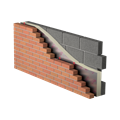Insulation for External Walls
U-value Calculator
Start your U-value calculationBuilding two skins of masonry (brick and/or blockwork) either side of an air cavity has been the most popular method for constructing external walls in the UK for about a century. From its development to address some of the flaws of traditional solid wall construction, it has gradually evolved in response to improving insulation technology and the development of building regulations relating to energy efficiency.
In a full-fill masonry cavity wall the residual cavity between the two leaves of masonry is entirely filled with insulation. Third-party accreditation in the form of BBA certification means that the insulation is guaranteed not to allow wind-driven rain to penetrate across the cavity, ensuring that the wall retains its original function of keeping the inner leaf of the structure dry.
Key Considerations
When using Celotex products, you need to satisfy yourself that use of the product meets all relevant national Building Regulations and guidance as well as local, national and other applicable standards relevant for your construction or application, including requirements in relation to fire and applicable height restrictions. In addition to the product datasheet, please refer to the following product documents:
- BBA certificates - where applicable to the application
- Declarations of Performance
- Health & safety datasheets
Celotex products should not be used in the external walls of buildings over 11 metres in height. Recent changes to Building Regulations mean that only non-combustible insulation or insulation of limited combustibility should be used in buildings of that height.
The building detail is for illustrative purposes only. It does not constitute advice and should not be relied upon.




